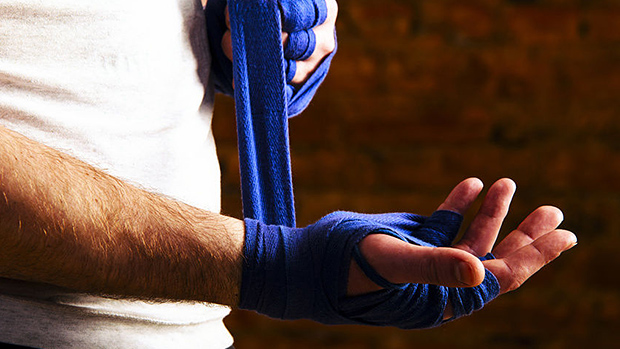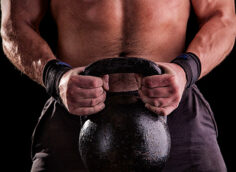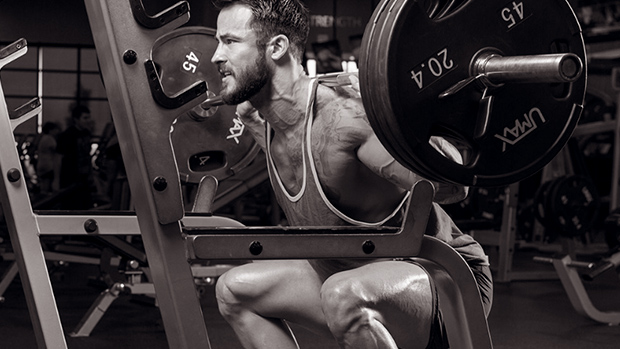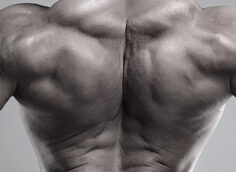No matter what kind of fighter you are, you must respect the balance between strength, endurance, and mobility. If you focus too much on one, others are sure to fall behind.
I've trained many different types of athletes over the years, but fighters have always been my favorite. That's because a fighter needs to be the total package. Don't get me wrong, athletes in most sports must possess high levels of multiple fitness qualities, but few need those qualities built to the extent of a mixed martial arts fighter.
I'm going to outline the steps that a fighter should take to help balance out his fitness levels. But this information isn't just for fighters. Anyone can benefit from the following principles.
1 – Identify Possible Movement Dysfunctions
First you must identify any basic movement disorders. If you skip this step, you'll get injured in no time. There's no sense in adding horsepower to a racecar that has bent rims, rickety ball joints, and an unstable chassis.
One of the best products to identify movement dysfunctions is Gray Cook's Functional Movement Screen DVD. It's simple, user-friendly, and highly effective for identifying movement dysfunctions that often lead to injuries. This is a valuable tool for anyone, not just fighters.
2 – Are You In Pain? Don't Work Through It!
Fighters are obviously known for being tough S.O.B's. This can beneficial at times and detrimental at others – especially during strength training sessions. If you suffer from pain in any joint, you should never try to work through it. If you do, I can almost guarantee the problem will get worse.
When I started working with Rickson Gracie's fighters, many said they were surprised at the caution I use when training athletes. I politely reminded them that 90% of the guys were already suffering from joint pain and dysfunction. They expected the "lift fast guy" to force them to scream in pain and bloody agony as I zapped them with a cattle prod. "Faster you bastards!" is what they expected to hear.
However, I was hired by the Gracie facility not just for my strength training knowledge, but for my ability to identify and correct joint injuries. After all, jiu-jitsu is designed to put a joint in a position it's not supposed to be in.
Find a reputable soft-tissue specialist, such as an ART practitioner, for starters. Just remember that you don't crank up the music until you've got a good set of speakers, or something's sure to blow.
3 – My Real Strength Guidelines
Sometimes I feel like I've been misquoted more than a hooker with a speech impediment. At the top of the list of hyperbolic bullshit is what I've read and heard about my own purported strength requirements for a fighter. It's time to set this nonsense straight. (And since I prefer clean air, I'll do my best to refrain from burning any bridges.)
First off, it's been said that I require fighters to squat and deadlift 2.5 x their bodyweight. I didn't. I said squat ordeadlift. If you're tall with long femurs, you're not built for squats. You'll probably break down your joints before achieving a 2.5 x body weight squat. That, of course, is counter-productive to building a strong, healthy body.
Second, a 2.5 x bodyweight squat or deadlift is not a requirement! It's simply a benchmark. What I'm saying is this: if you're built for the deadlift, it's a good idea to include maximal strength training with the deadlift until you can lift 2.5 x bodyweight.
It doesn't mean you'll absolutely win more fights, it just means your posterior chain will have all the strength it'll ever need, in any athletic situation.
When you do the math, you'll see that I'm recommending a 195-pound fighter to strive for, over time, a 485-pound deadlift. That's not excessive. And even if he never achieves it, the effort towards the goal is what's most important.
Third, for those who weigh over 200-pounds, the ratio starts to shift lower. A 250-pound fighter doesn't need a 625-pound squat or deadlift. For him, I'll shoot for something closer to a double bodyweight performance for whichever lift matches his skeletal structure.

This exercise is not an option, regardless of their structure.
A fighter is extremely limited by the time he can devote to maximal strength training. Few professional fighters can spend more than two sessions per week with maximal loads.
By setting a benchmark for maximal strength with the squat or deadlift, what I'm really doing is assessing whether or not I need to devote time to the lifts. In a perfect world, I wouldn't need to train those lifts because there are so many other fitness qualities they need to enhance.
If a fighter is anywhere close to a 2.0-2.5 x deadlift, I might only train the movement with maximal loads once every 4-6 weeks.
Maximal strength is hugely important for a fighter, especially one with poor fighting technique. Fedor doesn't need a 2.5 x bodyweight deadlift, because he's Fedor. Royce Gracie, when he first started competing, didn't need one either because his technique was far superior to his opponents.
These days, however, fighters need to exhibit high levels of numerous fitness qualities because the competition is greater than ever. I feel that maximal strength training has been the red-headed stepchild of the strength, endurance, and mobility triad.
In the spring of 2007, I was hired by a fighter to train him for a title bout. Since he was a Muay Thai fighter, he never performed any weightlifting before training with me. Therefore, we were able to double or triple his strength with many lifts within three months.
The day before the fight, he developed a nasty chest cold. When I went backstage to prepare him on fight day, he was a mess. He was wheezing, coughing, and could barely catch his breath during our warm-up.
His mucous-laden lungs simply couldn't transfer oxygen to his body. By the second round of the fight, the uber-anaerobic endurance we had built was gone. He was exhausted. But his newfound strength allowed him to overpower his opponent because his maximal strength was so much greater than the other guy's. He won the belt.
Many coaches have pointed to maximal strength as being a key factor in determining athletic performance. It's true, but many of these same coaches blatantly disregard my desire to build high levels of maximal strength with fighters. Fighters are power athletes, so they should strive for a lot of strength. That shouldn't be difficult to comprehend.
Don't tell me that maximal strength is important in one breath and then disregard my passion for building high levels of it in the next breath. You can't have it both ways.
4 – Save Your Shoulders
Many times, a fighter's shoulders exhibit a length-tension relationship that's completely out of whack. Their pecs and lats are too short and tight, their external rotators and serratus muscles are weak, their rhomboids are weak, their lower trap strength is pathetic, and their anterior shoulder mobility is sub-par. These dysfunctions lead to chronic shoulder pain while also obstructing future strength and mobility enhancement.
I've lost count how many fighters came to me with wrecked shoulders after including one-arm kettlebell snatches in their training program. The "catch" portion of the exercise is the real problem for many athletes – it's simply too stressful on the connective tissue of the shoulder joints.
But the problem wasn't the movement as much as it was the dysfunction that preceded it. Anytime you're training an athlete, or choosing an exercise, you must respect the risk-to-benefit relationship.
A kettlebell snatch is a high-risk exercise so I avoid them with most fighters. Better alternatives are exercises that challenge the overhead pressing muscles as statically as possible.
Turkish get-ups are great. So are overhead squats. I also like the overhead figure-8 walk with dumbbells. For the overhead figure-8, all you need to do is grab a pair of dumbbells, hold them overhead with your palms facing each other, and walk in a figure-8 pattern for one minute.
These three exercises make sure that you'll enhance shoulder stability without breaking down the joints. The risk is low and the benefits are high.
Also, to augment anterior shoulder mobility, I often use one more exercise. It's been called many names: shoulder dislocation, overhead pull, etc. Whatever you call, it's effective for many fighters. The key is to keep your arms straight throughout the exercise and attempt to move your grip closer together over time. My athletes start with 2-3 sets of 10 reps everyday.

Start position

Straight arms reaching backwards

Ideal end point, before returning to start position
5 – Develop Specific Endurance
Long-distance running will develop general endurance. So will bike sprints. But neither is specific to the endurance needs of a mixed martial arts fighter.
Take an elite jiu-jitsu fighter, for example. He might be able to roll with other fighters for 30 minutes straight without any noticeable fatigue. But as soon as you stand him up and force him to throw punches for 10 minutes, he's completely exhausted. The problem isn't his general endurance; the problem is that he's lacking specific endurance in the muscles that need it most.
Two of the most important areas that require maximum endurance are the shoulders and the posterior chain. To build shoulder endurance, you need to throw a lot of punches. That's a no-brainer.
But from a strength and conditioning standpoint, you should also include high-rep overhead squats, rope jumping, front squats with a plate , and bent-over crucifix holds, just to name a few.
High rep overhead squats


For total body maximal strength development for athletes, there are few exercises better than overhead squats with more than 80% of your 1RM. However, if shoulder endurance is lacking, you should incorporate high rep overhead squats with a lighter load.
Start with a load that allows you to do 25 reps with perfect form. This is usually just an empty bar. Every 48 hours, repeat the exercise and add a few more reps. Your goal should be 50 reps with perfect form.
Then, increase the load, drop back down to 25 perfect reps, and repeat the process. This is an excellent way to build shoulder endurance while enhancing mobility.
Jumping rope
This is one of the most effective forms of energy systems training for fighters because it's an anaerobic exercise. Remember, fighters need to primarily develop anaerobic endurance.
Jumping rope also enhances shoulder endurance. The key is to avoid keeping your elbows tucked to your sides and simply flipping your wrists. You should hold your elbows away from your sides and swing your arms, in order to recruit the shoulder muscles to a greater degree.
It'll suck at first because your shoulders will burn like hell, but it'll make a world of difference over time. Your goal is to continuously jump for 10 minutes, non-stop, at a pretty fast clip.
Front squat with a load held in front


The front squat is a necessary addition to any fighter's strength and conditioning program. The traditional version, with maximal loads, is outstanding for building total body strength.
For many, simply holding a load (plate, dumbbell, kettlebell, etc.) with your arms straight in front is even better. You'll develop core stability strength and you'll enhance shoulder endurance.
Hold a load that allows you 1-2 sets of 25 reps. Add a few reps to the exercise every 2-3 days. Work up to 50 reps, then increase the load, and start over with 25 reps to repeat the process.
This exercise is great with low reps, too. But for fighters, I prefer the high rep version because of the carryover to shoulder endurance.
Bent-over crucifix hold

A joint is only as healthy as it's balance of strength and mobility. I've talked a lot about building shoulder endurance, but the picture isn't complete without addressing the posterior portion.
One exercise that's outstanding for fighters is the bent-over crucifix hold. Hold a light dumbbell in each hand with your arms held out to the sides, parallel to the ground. Push your hips back and shift your trunk forward, until it's just above parallel to the ground. Your back should be flat, your head neutral, and your knees slightly bent. Your palms should be facing down. Hold this position for time.
This exercise serves many important purposes. First, it builds strength endurance in the posterior portion of the shoulder. A healthy joint must possess a balance of strength. By enhancing posterior shoulder endurance, you'll shift the length-tension relationship in your favor.
Second, the bent-over crucifix hold builds endurance in the entire posterior chain. I've seen many athletes who could deadlift 2.5 x their bodyweight, but they couldn't hold the bent-over position, without additional load, for two minutes. That's not a healthy back.
Research has demonstrated, time and again, that sufficient endurance strength is a key component of lower back health. The higher it is, the lower your chances of developing a back injury.
It's wise to include the bent-over crucifix hold in your training program. Start very light, maybe even without any weight, and hold for two minutes. Eventually, increase the intensity by holding light dumbbells in your hand.
Heavy bag walk
Another effective exercise that challenges total body anaerobic endurance, while also building your upper back strength, is the heavy bag walk. For my athletes, I use a 100-pound bag, and have them walk or run for one minute. This is an excellent addition to any fighter's program. The key is to maintain good posture throughout the drill.
6 – Reduce Inflammation
Fighters typically like to be sore. They're old school, after all. They equate pain with results. Convincing fighters that I don't want them to be sore has been one of my biggest challenges. The last thing a fighter needs is an overtaxed immune system, so it's imperative to control inflammation.
I recommend Flameout® to all of my fighters.
If you happen to also be a person who doesn't get enough fruits and vegetables each day, I highly recommend Biotest's Superfood. Even if you are consuming adequate nutrients it's still good insurance to keep your body in balance.
7 – Take Surge® Workout Fuel
One thing I want to make perfectly clear is that I receive no financial benefit by recommending any supplement. With that in mind I must say that Biotest's Surge Workout Fuel has proven to be an invaluable aid to many of my fighter's training programs.
If you're someone who suffers from nausea while training anaerobic endurance, this supplement could prove to be a Godsend, since it buffers proton accumulation. Also, this supplement could allow you to train for longer periods of time at a higher intensity. Finally, it'll help you recover faster.
Second to healthy fats, Biotest's Surge® Workout Fuel is a great cornerman for the vast majority of fighters.
Final Words
As I told the Rickson Gracie team during our first meeting: "I'm not here to make you a better fighter, that's the instructor's job. I'm here to make you a better athlete."
Incorporating all of the tips in this article will make you a well-balanced, ass-kicking, fighting machine!





